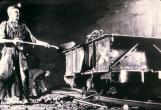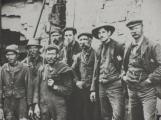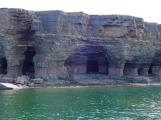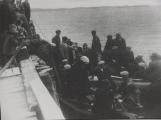1
Aerial view of Bell Island looking from west to east.June, 2002
Conception Bay, Newfoundland and Labrador

2
Bell Island is located in Conception Bay, on the northern part of the Avalon Peninsula. The island is about 9 km long by 3 km. wide, and is serviced by a year-round car and passenger ferry across "The Tickle" (the body of water between the island and the community of Portugal Cove).4
As with many places in Newfoundland, the first settlers on Bell Island lived primarily by fishing and farming. Farming was particularly important, owing to the island's unusually rich topsoil. Throughout the nineteenth century, the seal hunt drew large numbers of men from Bell Island and all around Conception Bay. The Pitt family opened a brickyard on Bell Island in 1848, and the Rees family operated a shipyard on the island, in Lance Cove, for a period during the 1800s.5
Early surface mining on the north east side of Bell Island.1900
Bell Island, Newfoundland and Labrador
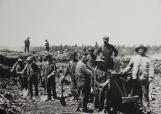
6
It was not until the 1890s, however, that the Bell Island deposits drew serious attention from professional mining interests. By 1892, the deposits had come under control of the Butlers of Topsail, who brought in agents of the New Glasgow Coal, Iron and Railroad Company (later called the Nova Scotia Steel and Coal Company) to begin developing the site. Thomas Cantley, Secretary of Nova Scotia Steel and Coal, called the minesite "Wabana", which is believed to be an Abenaki Indian word meaning "the place where daylight first appears", and mining began in the summer of 1895.8
Miners at the entrance of one of the first underground mine shafts.1902
Bell Island, Newfoundland and Labrador
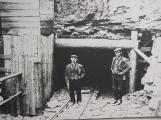
9
In 1899, a second company joined Nova Scotia Steel and Coal when the Whitney Company (later called the Dominion Steel Corporation) purchased rights to the large "lower bed" of ore that lay under the Scotia company's "upper bed". Both of these beds ran under the sea floor of Conception Bay, and after surface mining had exhausted the easily accessible ore, workers began the giant task of reaching and extracting these submarine beds.11
There are roughly four billion tons of ore left in the mines, but the industry shut down because of the high cost of getting the ore from the mine to the market.There were six mines in total during the course of the industry at Bell Island. Four of the mines, numbers 2, 3, 4 and 6, went submarine - meaning the mines actually went under the sea floor. The other two mines (1 and 5) went underground and broke out at the shoreline.
12
Miner hand loading ore car at 900' west level, No 3. MineAugust, 1949
Bell Island, Newfoundland and Labrador
